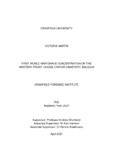JavaScript is disabled for your browser. Some features of this site may not work without it.
| dc.contributor.advisor | Shortland, A | |
| dc.contributor.advisor | Harrison, K | |
| dc.contributor.advisor | Braekmans, D | |
| dc.contributor.author | Martin, V | |
| dc.date.accessioned | 2023-03-13T15:49:51Z | |
| dc.date.available | 2023-03-13T15:49:51Z | |
| dc.date.issued | 2021-04 | |
| dc.identifier.uri | https://dspace.lib.cranfield.ac.uk/handle/1826/19295 | |
| dc.description | © Cranfield University 2021. All rights reserved. No part of this publication may be reproduced without the written permission of the copyright owner. | en_UK |
| dc.description.abstract | The First World War took place between 1914 and 1918, with conflict occurring in Europe and across the globe. By the end of the War, the bodies of the British and Commonwealth dead were scattered across France and Belgium. It was decided to move single graves or small cemeteries into bigger cemeteries that were being built by the Imperial War Graves Commission. This process was called “concentration”, and involved searching the battlefields for graves, then excavating and attempting to identify the bodies present, prior to their reburial in a concentration cemetery. This thesis focuses on the concentration process and specifically examines a sample of graves from Hooge Crater Cemetery, Belgium. The main research aim is to understand the range of errors that occurred during concentration and identification, and how prolific they were. A historical and literature review was completed, followed by the analysis of data from 109 graves from Hooge Crater Cemetery that were re-exhumed in 1920. This proved that within the sample, a high number of errors occurred in the original concentration work. Following this, 163 burial returns containing the details of 1013 graves from Hooge Crater Cemetery were selected for detailed analysis. The information from these burial returns was gathered and reviewed, and where possible was plotted onto First World War trench maps. This data provides new insights into where and when bodies were concentrated, the type of methods used for identification and how these methods changed over time. The research presented here demonstrates that identification rates varied, and were influenced by several factors including burial location, quantity of body present, time of concentration and primary identification method used. Overall, this thesis expands our knowledge of First World War grave concentration, including how the battlefields were searched and how bodes were identified. | en_UK |
| dc.language.iso | en | en_UK |
| dc.relation.ispartofseries | PHD;PHD-21-MARTIN | |
| dc.rights | © Cranfield University, 2015. All rights reserved. No part of this publication may be reproduced without the written permission of the copyright holder. | |
| dc.subject | Grave location | en_UK |
| dc.subject | Exhumation | en_UK |
| dc.subject | Identification methods | en_UK |
| dc.subject | Imperial War Graves Commission | en_UK |
| dc.title | First World War Grave Concentration on the Western Front: Hooge Crater Cemetery, Belgium | en_UK |
| dc.type | Thesis | en_UK |
| dc.description.coursename | PHD | en_UK |
